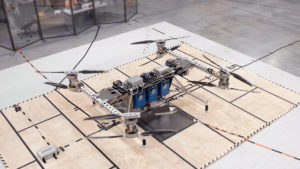No products in the cart.
Boeing’s cargo UAV a shot in the arm for drone delivery market [VIDEO]

A working prototype cargo drone unveiled today by Boeing marks the entry of the world’s largest aircraft manufacturer into the unmanned electric air cargo air vehicle space. While analysts have predicted for some time now that drones are on course to transform the logistics sector, Boeing’s additional aerospace muscle represents a seismic shakeup of the industry, with the Chicago-based company now plowing its extensive technology and resources into developing this still incipient technology.
The drone is powered by an electric propulsion system and outfitted with eight counter-rotating propellers, allowing for vertical and horizontal flight. It measures 4.6 meters long, 5.5 meters wide and 1.2 meters tall, and weighs 339 kilograms.
David Neely of Boeing Research & Technology said that the drone would eventually be able to deliver up to 227 kilograms of cargo within a fifteen- to thirty-kilometer radius, adding that it could, “change the way we deliver goods.” Those specs position Boeing’s new drone in the last-mile delivery range, rather than long-distance cargo transport, where drones more closely resemble conventional aircraft.
The news is a development that Boeing’s chief technology officer Greg Hyslop said would, “change air travel and transport… We’ll look back on this day as a major step in that journey.”
Here’s a Boeing video showing the prototype in action:
Boeing called its new drone an, “unmanned electric vertical-takeoff-and-landing (eVTOL) cargo air vehicle (CAV) prototype” and said that it will use its first model to “test and evolve Boeing’s autonomy technology for future aerospace vehicles.”
Boeing told Air Cargo World that the end goal was “market-driven solutions that will someday offer customers the ability to carry hundreds of pounds over broad distances in a way that makes it useful and relevant to them.”
The aerospace company said that the technology tested on this prototype will “open up new possibilities for delivering time-sensitive and high-value goods, conducting autonomous missions in remote or dangerous environments, and other cargo and logistics applications. This could include oil rig and ship resupply, port operations, mining, construction, and logistics companies that move goods between distribution centers. We fully expect partners around the world will create new ways of applying this technology.”
While we aren’t likely to see Boeing’s drones delivering couches and groceries any time soon, there are a number of important takeaways worth considering.
Firstly, Boeing will use the prototype as a “flying test bed” to develop its autonomous technology for future applications. “Our new CAV prototype builds on Boeing’s existing unmanned systems capabilities and presents new possibilities for autonomous cargo delivery, logistics and other transportation applications,” said Steve Nordlund, Boeing HorizonX vice president. “Boeing has the regulatory know-how and systematic approach to deliver solutions that will shape the future of autonomous flight.”
Boeing said that it drew on expertise from across the areas of aviation it covers to rush the drone from concept to flight in only three months. Most drone manufacturers spend years developing technology and testing it. Boeing, on the other hand, has more than a hundred years of aviation research under its belt, and recently acquired aviation and aeronautics research company Aurora Flight Sciences, meaning that it’s going to move fast.
The drone’s eight propeller vertical-liftoff “quadcopter” design has range limitations that exclude the sort of airfreight that Air Cargo World mostly covers – conventional air freight – instead placing it in the shorter-range last-mile or perhaps short-distance deliveries between clustered DCs.
That’s also a market in which Amazon.com and Chinese e-commerce retailer JD.com are very active, adding an element of competition, as retailers and logistics companies rush to cut costs against a backdrop of growing demand for e-commerce deliveries.

















